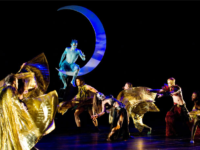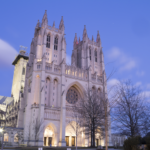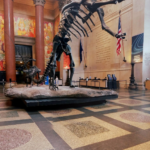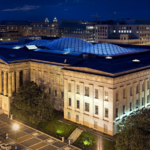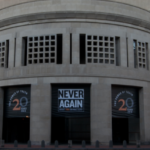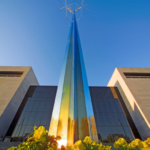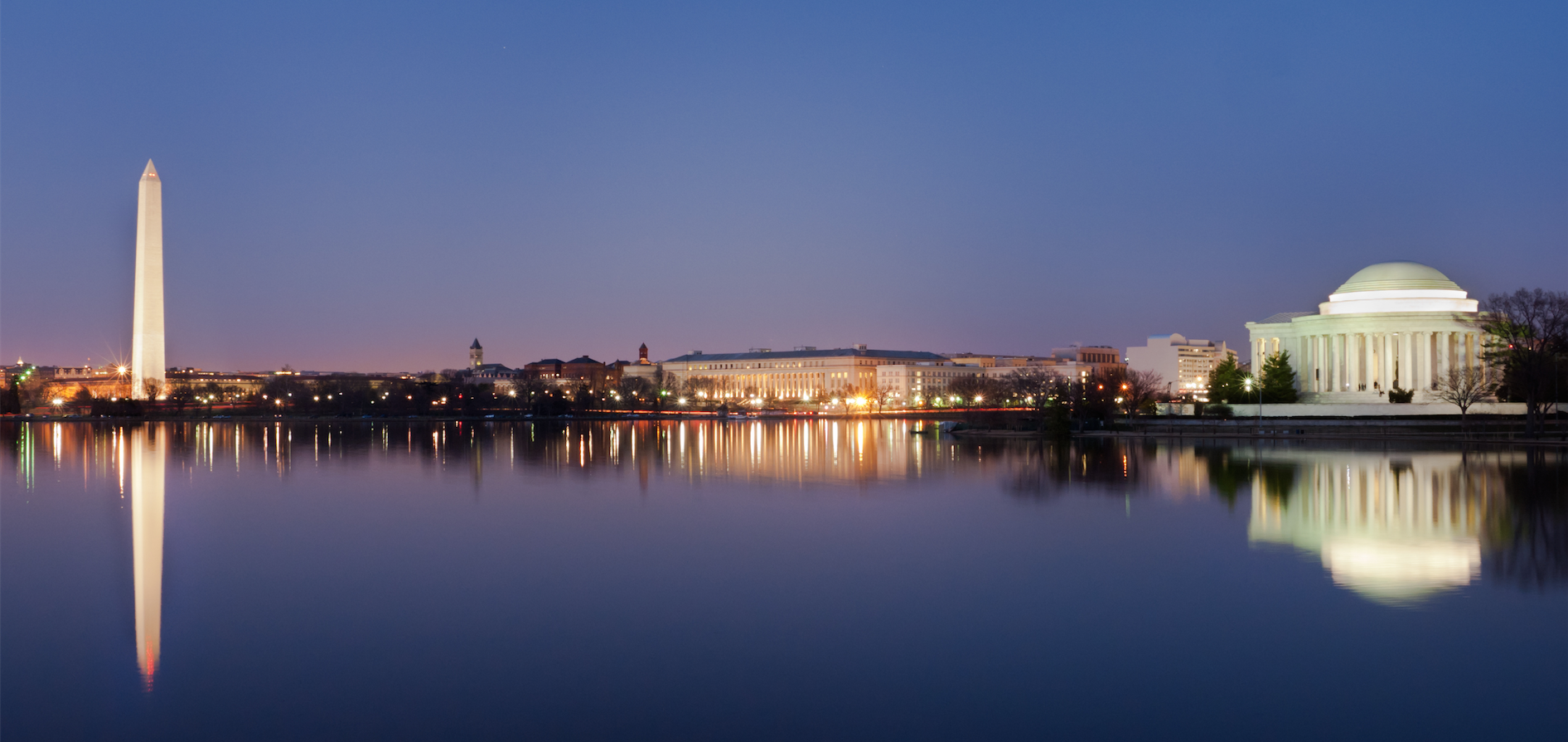

Memorials
Korean War Veterans Memorial
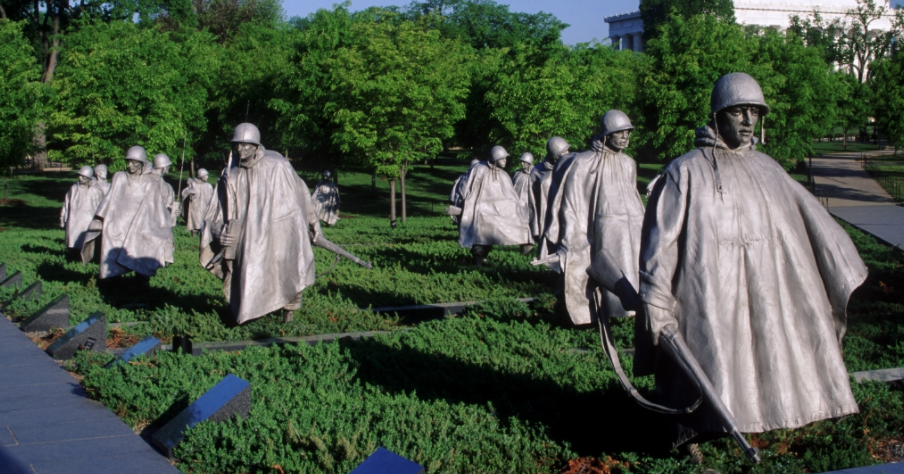
The Korean War Veterans Memorial is located in Washington, D.C.’s West Potomac Park, southeast of the Lincoln Memorial and just south of the Reflecting Pool on the National Mall. It commemorates those who served in the Korean War.
The main memorial is in the form of a triangle intersecting a circle. Walls: 164 feet (50 m) long, 8 inches (200 mm) thick; more than 100 tons of highly polished “Academy Black” granite from California: more than 2,500 photographic, archival images representing the land, sea and air troops who supported those who fought in the war are sandblasted onto the wall. Wikipedia — Read more
Vietnam Veterans Memorial
The Vietnam Veterans Memorial was founded by Jan Scruggs, who served in Vietnam (in the 199th Light Infantry Brigade) from 1969-1970 as a infantry corporal. He wanted the memorial to acknowledge and recognize the service and sacrifice of all who served in Vietnam. The Vietnam Veterans Memorial Fund, Inc. (VVMF), a nonprofit charitable organization, was incorporated on April 27, 1979, by a group of Vietnam veterans (John Wheeler, Chairman of the Board for VVMF, served in Vietnam as a captain at U.S. Army headquarters from 1969-1970; Robert Doubek, VVMF project director, then executive director, served in Vietnam from 1968-1969 as an Air Force intelligence officer) in Washington, D.C. Jan Scruggs (President of VVMF) lobbied Congress for a two acre plot of land in the Constitution Gardens. Significant initial support came from U.S. Senators Charles McC. Mathias, Jr. (on November 8, 1979, Senator Mathias introduced legislation to authorize a site of national parkland for the Memorial) of Maryland and John W. Warner (Senator Warner launched the first significant financial contributions to the national fund raising campaign) of Virginia. On July 1, 1980, in the Rose Garden, President Jimmy Carter signed the legislation (P.L. 96-297) to provide a site in Constitution Gardens near the Lincoln Memorial. It was a three and half year task to build the memorial and to orchestrate a celebration to salute those who served in Vietnam. Read more…
World War II Memorial
The World War II Memorial honors the 16 million who served in the armed forces of the U.S. during World War II, the more than 400,000 who died, and the millions who supported the war effort from home. Symbolic of the defining event of the 20th Century, the memorial is a monument to the spirit, sacrifice, and commitment of the American people to the common defense of the nation and to the broader causes of peace and freedom from tyranny throughout the world. It will inspire future generations of Americans, deepening their appreciation of what the World War II generation accomplished in securing freedom and democracy. Above all, the memorial stands as an important symbol of American national unity, a timeless reminder of the moral strength and awesome power that can flow when a free people are at once united and bonded together in a common and just cause. Read more…
Thomas Jefferson Memorial
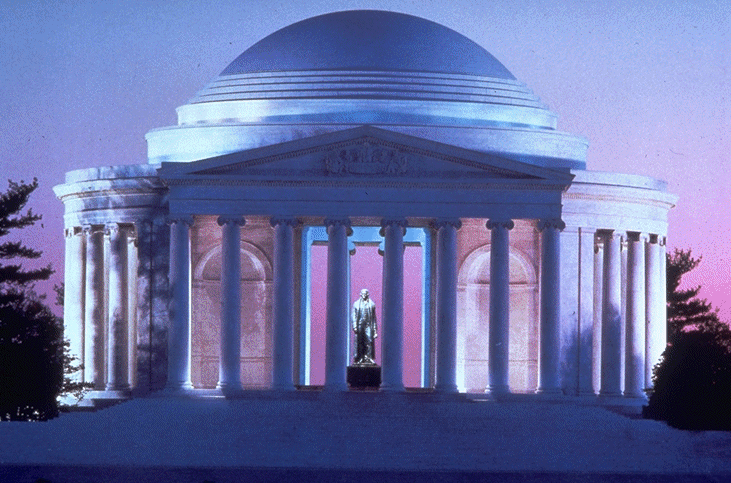
Thomas Jefferson Memorial is a presidential memorial in Washington, D.C. that is dedicated to Thomas Jefferson, an American Founding Father and the third President of the United States. The neoclassical building was designed by John Russell Pope. It was built by Philadelphia contractor John McShain. Construction began in 1939, the building was completed in 1943, and the bronze statue of Jefferson was added in 1947.
The Jefferson Memorial is managed by the National Park Service under its National Mall and Memorial Parks division. In 2007, it was ranked fourth on the List of America’s Favorite Architecture by the American Institute of Architects.
The current site of the Memorial was originally created using landfill dredged from the Potomac River in the late 19th century. It became a popular bathing beach for Washingtonians and other locals.
It became apparent that the site was well suited for another high-profile memorial since it sat directly south of the White House. By 1901 the Senate Park Commission, better known as the McMillan Commission, had proposed placing a pantheon-like structure on the site hosting “the statues of the illustrious men of the nation, or whether the memory of some individual shall be honored by a monument of the first rank may be left to the future”; no action was ever taken by Congress on this issue. Read more…
Thomas Jefferson Memorial is part of the National Mall and Memorial Parks. The site lies at the southern end of the National Mall, adjacent to the Tidal Basin in West Potomac Park. The memorial rests within the sightline to and from the White House, which stands one mile to the north. Directions
Roosevelt Memorial
“The only thing we have to fear is fear itself.” These are the words of our 32nd President, a man who embodied the meaning of the word courage. Despite being stricken with polio at age 39 and paralyzed from the waist down, he emerged as a true leader, guiding our country through some dark times: the Great Depression and World War II. The memorial honors this man, his story, and his era.
The Franklin Delano Roosevelt Memorial is a presidential memorial dedicated to the memory of U.S. President Franklin Delano Roosevelt and to the era he represents. For the memorial’s designer, landscape architect Lawrence Halprin, the memorial site represents the capstone of a distinguished career, partly because the landscape architect had fond memories of Roosevelt, and partly because of the sheer difficulty of the task.
Dedicated on May 2, 1997 by President Bill Clinton, the monument, spread over 7.5 acres (3.0 ha), traces 12 years of the history of the United States through a sequence of four outdoor rooms, one for each of FDR’s terms of office. Sculptures inspired by photographs depict the 32nd president alongside his dog Fala. Other sculptures depict scenes from the Great Depression, such as listening to a fireside chat on the radio and waiting in a bread line, a bronze sculpture by George Segal. A bronze statue of First Lady Eleanor Roosevelt standing before the United Nations emblem honors her dedication to the UN. It is the only presidential memorial to depict a First Lady.
Considering Roosevelt’s disability, the memorial’s designers intended to create a memorial that would be accessible to those with various physical impairments. Among other features, the memorial includes an area with tactile reliefs with braille writing for people who are blind. However, the memorial faced serious criticism from disabled activists. Some of the braille and reliefs were placed well above the reach of even a very tall person, rendering the braille pointless because no blind person could reach high enough to read it. Read more…
Franklin Delano Roosevelt Memorial is part of the National Mall and Memorial Parks. The memorial lies along the southwest shore of the Tidal Basin in West Potomac Park, near the intersection of Independence Avenue, West Basin Drive, and Ohio Drive, SW. More information
Martin Luther King, Jr. Memorial
The monumental memorial is located at the northwest corner of the Tidal Basin near the Franklin Delano Roosevelt Memorial, on a sightline linking the Lincoln Memorial to the northwest and the Jefferson Memorial to the southeast. The memorial opened to the public on August 22, 2011, after more than two decades of planning, fund-raising and construction.
Martin Luther King, Jr. (January 15, 1929 – April 4, 1968) was an American clergyman, activist, and prominent leader in the African-American Civil Rights Movement. He is best known for being an iconic figure in the advancement of civil rights in the United States and around the world, using nonviolent methods following the teachings of Mahatma Gandhi. King is often presented as a heroic leader in the history of modern American liberalism.
Delivering the “I Have a Dream” speech at the 1963 Washington D.C. Civil Rights March.
A Baptist minister, King became a civil rights activist early in his career.[13] He led the 1955 Montgomery Bus Boycott and helped found the Southern Christian Leadership Conference in 1957, serving as its first president. King’s efforts led to the 1963 March on Washington, where King delivered his “I Have a Dream” speech. There, he expanded American values to include the vision of a color blind society, and established his reputation as one of the greatest orators in American history.
In 1964, King became the youngest person to receive the Nobel Peace Prize for his work to end racial segregation and racial discrimination through civil disobedience and other nonviolent means. By the time of his death in 1968, he had refocused his efforts on ending poverty and stopping the Vietnam War.
King was assassinated on April 4, 1968, in Memphis, Tennessee. His assassination led to a nationwide wave of race riots in Washington D.C., Chicago, Baltimore, Louisville, Kentucky, Kansas City, and dozens of other cities. He was posthumously awarded the Presidential Medal of Freedom in 1977 and Congressional Gold Medal in 2004; Martin Luther King, Jr. Day was established as a U.S. federal holiday in 1986, and was first observed in all states in 2000. Read More
Lincoln Memorial
The Lincoln Memorial occupies a prominent space on the National Mall in Washington, DC and is a tribute to President Abraham Lincoln, who fought to preserve our nation during the Civil War. The Lincoln Memorial stands at the west end of the National Mall as a neoclassical monument to the 16th President. The memorial, designed by Henry Bacon, after ancient Greek temples, stands 190 feet long, 119 feet wide, and almost 100 feet high. It is surrounded by a peristyle of 38 fluted Doric columns, one for each of the thirty six states in the Union at the time of Lincoln’s death, and two columns in-antis at the entrance behind the colonnade. The north and south side chambers contain carved inscriptions of Lincoln’s Second Inaugural Address and his Gettysburg Address. Lying between the north and south chambers is the central hall containing the solitary figure of Lincoln sitting in contemplation. The statue was carved in four years by the Piccirilli brothers under the supervision of the sculptor, Daniel Chester French. The statue of Lincoln is 19 feet high and weighs 175 tons. The original plan was for the statue to be only ten feet high, but this was changed so that the figure of Lincoln would not be dwarfed by the size of the chamber. A commission to plan a monument was first proposed in 1867, shortly after Lincoln’s death. The design for that plan called for six equestrian and 31 pedestrian statues of colossal size, with a 12-foot statue of Lincoln in the center. That project was never started for lack of funds. Learn More or Take the Virtual Tour.
